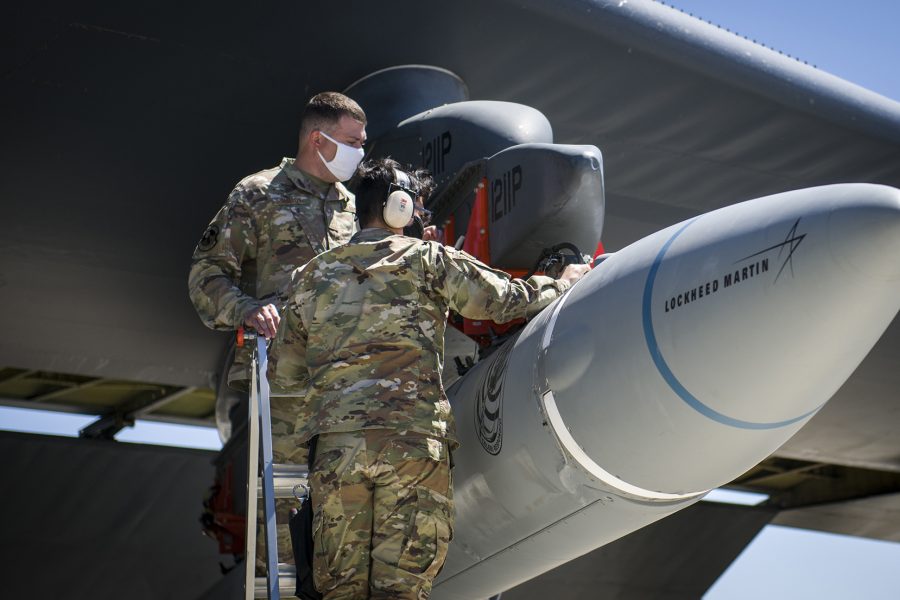Getting the Air-launched Rapid Response Weapon hypersonic missile into production before the end of fiscal 2022 depends on quick resolution of last week’s failure of the missile to make its first flight, the Air Force’s program executive officer for weapons said Aug. 4.
A failure review began immediately after the July 28 attempted test off the coast of California in which the rocket motor did not fire after separation from a B-52 test aircraft, said USAF weapons Program Executive Officer Brig. Gen. Heath A. Collins during the online Life Cycle Industry Days seminar.
“We’re just coming up on Day 7” since the failure, Collins said, adding that he did not have an update on why the missile failed.
The review will determine if the failure will affect the desired “early 2020s” initial operating capability. With a “quick and rapid resolution,” the transition to production can still likely happen by this time next year, but that requires at least two all-up successful tests of the weapon, he said. If the investigation is “prolonged, … or drives anything excessive from a redesign perspective, which we don’t know at this point, … it may impact our ability to meet the next test window,” Collins said.
For now, “We are still postured … to transition to award and production by the end of fiscal year 2022.” Lockheed Martin is the contractor for ARRW, and the company recently submitted its production proposals for the missile. The Air Force asked for $161 million in its fiscal 2022 budget submission to build 12 ARRW missiles.
Collins said Lockheed Martin’s $225 million loss on a classified program, reported in its second-quarter results last week, was not related to ARRW. Meanwhile Kenneth Possenriede, Lockheed Martin’s chief financial officer, unexpectedly resigned his post this week without giving a reason. Stock analysts speculated that it had to do with the write-down.
ARRW has experienced several test failures already. Collins said an April failure’s cause is understood, that a fix was made, and that the problem did not occur again in last week’s test. “The corrective action was sufficient and working,” Collins said. An Air Force press release noted that although the missile’s motor didn’t fire, the test demonstrated a successful release from the launch aircraft. It unfolded its fins and established navigational links. The test missile was not recovered.
Asked how many tries Lockheed Martin gets before the program is reconsidered, Collins said ARRW is the only boost-glide hypersonic missile the Air Force has on contract and that the program is constantly being “evaluated” for success.
“We also knew at the beginning this was a rapid-prototyping, … risky program,” Collins said. If not for congressional authorities to use streamlined program management and skip traditional methods, “we would not be where we are today.” Collins said the “mid-tier acquisition” approach was the right one for ARRW because it is appropriate for rapid prototyping and “new technology.” He said the Air Force will work through the root-cause investigation and get back to flight testing as soon as possible.
If ARRW proves unworkable, Collins said, “We certainly could go back to HCSW,” the Hypersonic Conventional Strike Weapon the Air Force curtailed in February 2020. The HCSW had been through its critical design review at the time the Air Force stopped the project, which had some common elements with Army and Navy hypersonic programs.
But, “You’d have to trade that with the amount of cost and schedule” it would take to get HCSW back up and producing hardware, he said.
Collins, who is also director of the Air Force Life Cycle Management Center’s Armaments Directorate, said the directorate is “tracking” language from House appropriators that would cut $44 million from the program line that funds ARRW and the unrelated Hypersonic Attack Cruise Missile—an air-breathing, as opposed to a boost-glide system—and said that if the change becomes law, “that would impact” a contract award because lowering the quantity purchased would raise cost per unit. The language raised concerns that the Air Force would enter production before the missile’s bugs have all been worked out. The directorate is working to increase transparency in the hypersonic programs, he said, and will split up ARRW and HACM funding lines in the future.
